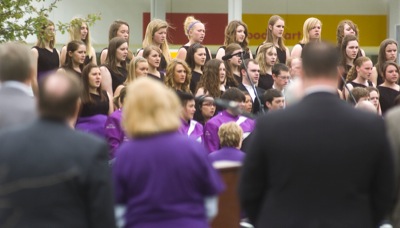Monday, May 6th, 2013
Fort Recovery honors frontier combatants
Monument to battles' dead 100 years old
By William Kincaid

Photo by Mark Pummell/The Daily Standard
U.S. Navy Commander Bradley E. Brewer presents a wreath at the Fort Recovery Monument on Sunday afternoon.
FORT RECOVERY - Several hundred people gathered at Monument Park on Sunday afternoon to commemorate the 100th anniversary of the Fort Recovery Monument and reflect upon a series of cornerstone battles responsible for the westward expansion of the United States.
Fort Recovery families and officials, state dignitaries and descendants of combatants who fought in the area filled the lawn of the 101-foot tall monument that sits atop the largest tomb of unknown soldiers in the United States. It is an imposing reminder of the men, women and children who died in the Battle of the Wabash, also known as St. Clair's Defeat, in 1791 or the Battle of Fort Recovery in 1794.
Comprised of North Carolina Gray granite, the monument, authorized by President William Howard Taft, was constructed by the Van Amringe Granite company of Boston, Mass., in late 1912 before being officially dedicated in 1913. It was modeled after the Washington Monument, Fort Recovery State Museum Director Nancy Knapke told the crowd.
"But this monument isn't built to commemorate a defeat or because of the greatness of that (first) battle," keynote speaker John Winkler said, "it's because the story of those battles is part of a larger and greater story, and that is indeed one of the greatest stories, perhaps the greatest story in American history, and one of the greatest stories in the history of human beings - and that is how there came to be a transition from 13 small colonies ... into a great nation from ocean to ocean that would tower over the 20th century, at least, like a great colossus."
U.S. Gen. Arthur St. Clair's historical campaign of 1791 in northwest Ohio to take control of the area between the Ohio River and the Great Lakes was a failure and one the nation's worst military fiascoes.
Winkler said on Christmas Day 1793, a group of soldiers had the very disagreeable task of building Fort Recovery on the site of that previous massacre that, as far as the eye could see, was littered with bones that had to be scrapped and carried away.
The tide turned for Americans in 1794 with the Battle of Fort Recovery, when the U.S. Army defeated the largest Native American force ever assembled. In addition to being one of the few times Native Americans attacked a fort, the battle led to the Treaty of Greenville in 1795.
Eighty to 90 years after the construction of the fort, a group of men who had to move the Wabash River in conjunction with the new railroad burned several trees. Small black rivers - molten lead from 10,000 musket balls lodged in the branches during the battles - ran down the trees, he said.
"This (Fort Recovery) is the best place in which to see that world that those people lived in, that world that is gone," Winkler said. "This is the only place I know where you can actually see so many of the places where events occurred."
Fort Recovery native and Ohio Department of Natural Resources Director Jim Zehringer spoke on behalf of himself and Gov. John Kasich, who couldn't attend the event.
Zehringer said the sculpture of the unnamed frontiersman standing on the west side of the monument recognizes the struggles and achievements of those buried there.
It has seen businesses come and go; young men leave to fight in wars they would never return from; generations of children cutting across the grass on their way to school; Memorial Day celebrations, as well as fires, floods, recessions and depressions, he said.
He quipped he even watched one man drive a mower into the cannon.
Several proclamations were issued by politicians. The Fort Recovery High School band and choir also performed several patriotic numbers.
Prior to the ceremony, descendants of people who fought in either of the two battles shared information. Knapke said about 100 descendants and members of their families attended Sunday's event.
Lewis Thompson of Waldron, Mich., spoke of his relative Nicholas McCarty, who died along the banks of the Wabash River in 1791 battling warriors of the Miami Nation.
According to Thompson, McCarty was driven to fight after Indians scalped his daughter in Kentucky and tomahawked his two grandsons to death. His daughter survived the scalping but had to wear a bonnet the rest of her life because of the bones exposed in her skull, he said.
"So you're looking at a man in his early 60s who joins the Kentucky Militia, who walks 200 miles... through wilderness, engages the Indians in what was probably hand-to-hand combat and died," Thompson said. "Quite often you hear politicians today say 'we must look forward (to) see how great we can become.' I say we must look backward and see the greatness that once was."
Knapke said all of the stories will be documented and preserved.
"It was a hard world, and the stories that they left for us are stories of a world that was exotic and colorful, dangerous and exciting and adventurous; it was a world in which those who lived lived hard lives," Winkler said. "So this monument stands also to remind us of not just people who are gone, but of whole worlds that are gone, and remind us that all worlds go."

Photo by Mark Pummell/The Daily Standard
Author John Winkler, keynote speaker of the 100th anniversary of the Fort Recovery Monument, speaks to a large crowd.

Photo by Mark Pummell/The Daily Standard
Fort Recovery high school band and show choir perform patriotic songs on Sunday.

Photo by Mark Pummell/The Daily Standard
Descendants of combatants who fought in Fort Recovery more than 200 years ago traveled from as far away as Texas and Florida to participate in the anniversary.




